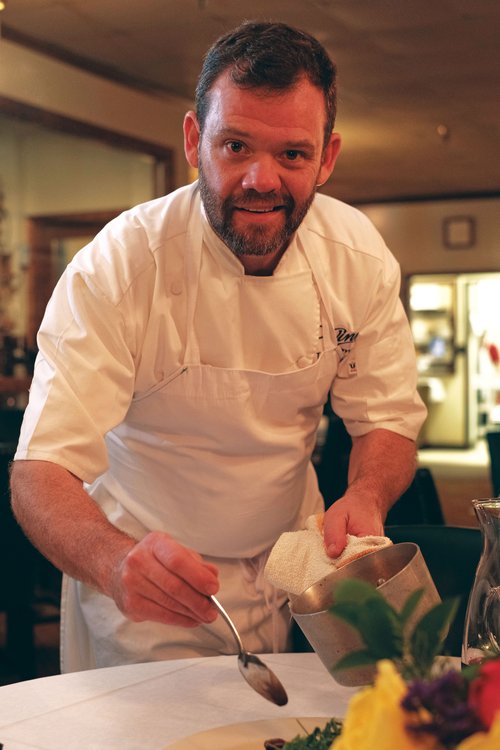Article:
Vinnie’s Steak House and Tavern mixes tradition with inventive new offerings
At Vinnie’s Steak House and Tavern, the seasonal desserts are so popular they inspired a dessert-themed calendar. Developed last year, this calendar was the brainchild of Chef and General Manager Tom Armstrong, who noticed that people would constantly ask which dessert was up next. He developed the calendar to show loyal dessert fans which delicacy is on deck—from spring’s blueberry crostata with peach ice cream, to fall’s carrot and persimmon cake with bacon fat frosting.
Vinnie’s Steak House dessert calendar follows the availability of local produce. Armstrong sees it as “kind of serendipitous the way nature creates these incredible combinations,” citing the strawberry shortcake with honeysuckle ice cream as an example. And although the desserts are ever-changing, repeat customers need not fret when their favorite leaves the menu. “As soon as one thing is gone, something else good is around the corner,” Armstrong says.
Indeed, something good has been around the corner for each of the 17 years Armstrong has been at the helm of Vinnie’s Steak House. A Raleigh native, he remembers Vinnie’s in its glory days when it opened in 1987. He joined as executive chef in 2006 and got to work reinstating the restaurant to the popularity it had once known. A focus on local ingredients and an updated menu accomplished that mission, and when the general manager eventually moved on, Armstrong had the opportunity to take on a new challenge and assume that role in addition to his chef duties.
Jacket Required
The way Armstrong thinks about his role has evolved over the years. Initially, he’d spend all day in the kitchen prepping, then put on a suit coat each night to participate in front-of-house activities. Now, things are different—he still makes sure to visit with guests, but he’s always wearing his chef jacket.
This decision can be attributed to two things, Armstrong says. For one, the kitchen is where he does his best work and is most comfortable, and he feels lucky to have hired a strong, trustworthy team in both the front and back of the house, enabling him to split his time. But Armstrong also says the chef coat adds an experiential element for the diners, who are always excited to receive a visit from the person who oversaw their dishes.
Armstrong times his visit carefully; he waits to visit patrons toward the end of their meal, then inquires about how each steak was cooked and how everything tasted. He gets a lot of positive feedback, he says, but recognizes that the constructive criticism is even more important.
Mixing Old With New
While tradition is important at a steakhouse that dates back to 1987, Armstrong has also been able to introduce new dishes over the years. The restaurant boasts a full steakhouse menu and a more casual tavern menu, both of which are always available. Just like the desserts, other special dishes rotate seasonally, such as the baked Pamlico Sound oysters, which features dried sherry, collards, bacon and whipped brie.
The mix of traditional and new dishes has attracted a diverse clientele, some of whom have incorporated Vinnie’s Steak House into their family traditions since the steakhouse opened, as well as new faces who have either recently moved to the area or were too young to have frequented the restaurant during its early days. Whether people want a quick bite or cocktail at the bar while watching a game, or a full sit-down dinner with family, Vinnie’s Steak House has something for everyone.
In his quest to keep the restaurant current, Armstrong makes sure to take advantage of opportunities that teach him new techniques. Several years ago, he was able to do a short training stint at several Michelin-starred restaurants in New York, which prompted him to bring back new approaches to working with familiar ingredients. One example of this is the “duck three ways,” which air-dries local Joyce Farms duck so that the flavors deepen and become richer. The process is similar to dry aging a steak, Armstrong says.
But staying put at home has taught this Raleigh native just as much, especially as the city’s food scene continues to expand with more local farmers and talented chefs. Armstrong sources everything locally where possible, including chicken from Joyce Farms in Winston-Salem, pork from Heritage Farms in Goldsboro and produce from Blue Sky Farms in Wendell.
Armstrong has invested a lot of work in Vinnie’s Steak House over the years, but emphasizes that he could not do any of it without his team. Now, he says, the restaurant has reached a place where the team can enjoy the fruits of their labor. It’s still hard work, but it’s fun work. “It’s like cooking for your friends and family every night,” he says.

Grilled North Carolina Bison Flank Steak With Horseradish Mashed Potatoes, Pea Shoots and Bordelaise Sauce
Serves 4 as a main course
Ingredients
2½–3 pounds of bison flank steak, trimmed
2 pounds of russet potatoes, peeled and halved
½ cup of milk, warmed
2 tablespoons of butter, at room temperature
1–2 tablespoons of prepared horseradish
1 carrot, peeled and chopped
1 onion, peeled and chopped
Course (or kosher) sea salt
1 celery rib, chopped
Black peppercorns, 1 tablespoon whole, 2 tablespoons cracked
1 bay leaf
2 cups of red wine (preferably a heavier red, like a cabernet)
4 cups of beef stock
1 cup of demi-glace (reduced veal stock)
12 ounces of fresh pea shoots
Finely ground white pepper
Directions for Making the Bordelaise Sauce
Sauté the carrot, onion and celery over medium-high heat for 3–4 minutes until they begin to brown slightly. Add the bay leaf, 1 tablespoon of whole black peppercorns and ½ teaspoon of salt. Stir to combine. Add the red wine and bring the mixture to a boil. Lower the heat to simmer and allow the mixture to reduce for about 5 minutes. Add the beef stock and demi-glace. Bring the mixture back to a simmer and allow it to reduce for about 30 minutes—until the sauce thickens enough to coat the back of a spoon. Strain the sauce through a fine-mesh strainer and keep it warm until you’re ready to serve it.
Directions for Making the Mashed Potatoes
Cover the potatoes by 2 inches with cold water and add 2 tablespoons of salt. Bring them to a boil. Lower the heat and simmer until the potatoes are fork tender. Drain well. Using a potato ricer, press the potatoes back into the cooking pot. (You can also use a potato masher, but the potatoes may be a little less smooth.) Add the milk and butter. Gently fold the milk and butter into the riced potatoes. Season the mixture to taste with salt, white pepper and horseradish. Keep it warm until ready you’re ready to serve it.
Directions for Grilling the Bison
Cut the flank steak into four 8-ounce portions (or have your butcher cut it for you). Season the steak with salt and cracked black pepper, to taste. Cook the flank steaks on a hot grill for approximately 3–4 minutes per side for medium-rare. Allow the flank steaks to rest for 10 minutes before slicing them. (Be sure to slice against the grain of the meat for tenderness.)
Directions for Assembling the Meal
Place a scoop of mashed potatoes just above the center of each plate. Fan the sliced flank steaks around the bottom of the potatoes. Drizzle the bordelaise sauce over the meat and around the plate. Top each scoop of potatoes with a generous twist of pea shoots.


